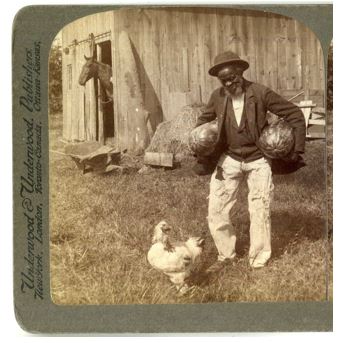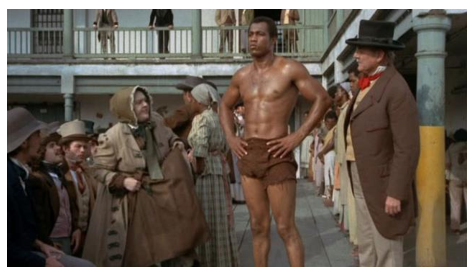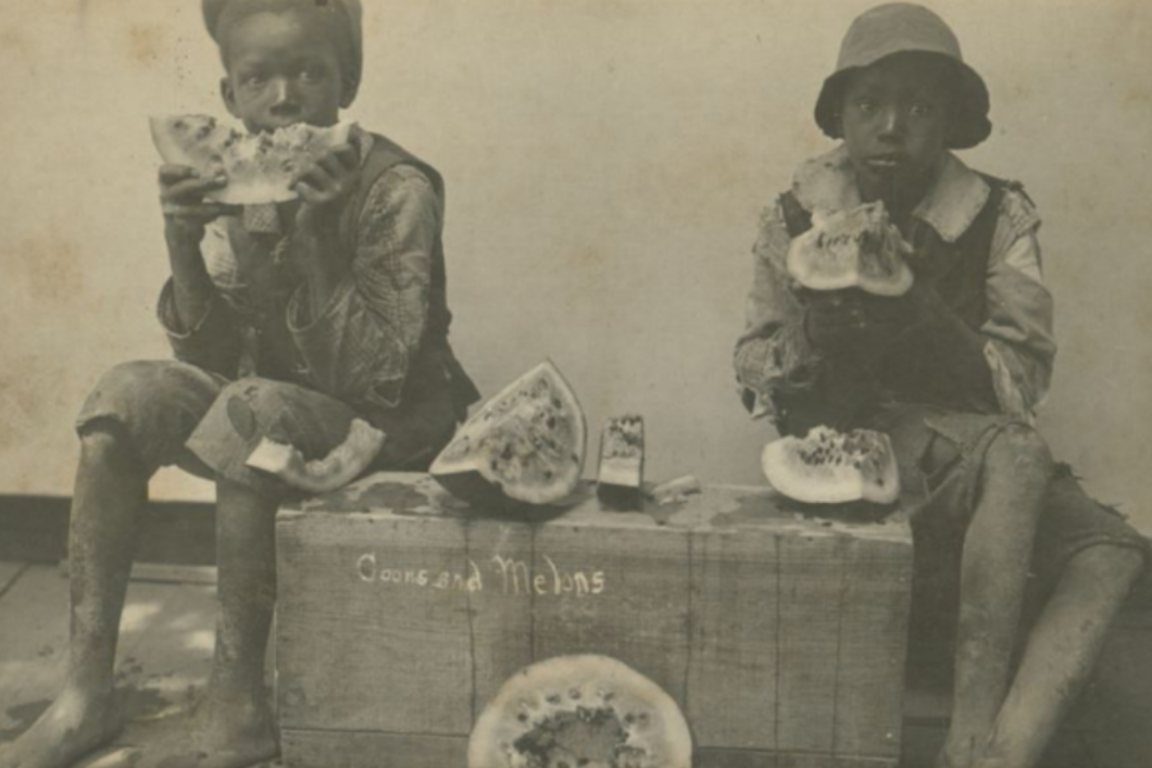Collection Connection
There are more than 100 items related to Stereotypes of African Americans in the NMAAHC Collection, including:
- Lithograph depicting a pig knocking over a “zip coon”
- An original print edition of Professor Charles Carroll’s book, "'The Negro a Beast', or, 'In the Image of God'"
- Postcard depicting a caricatured boy eating a slice of watermelon (circa 1909) by illustrator Richard Felton Outcault
- Coin bank in the form of "Mammy" seated on a chamber pot
Widespread and Pervasive Stereotypes of African Americans
Stereotypes of African Americans grew as a natural consequence of both scientific racism and legal challenges to both their personhood and citizenship. In the 1857 Supreme Court case, Dred Scott v. John F.A. Sandford, Chief Justice Roger B. Taney dismissed the humanness of those of African descent. This legal precedent permitted the image of African Americans to be reduced to caricatures in popular culture.
Decades-old ephemera and current-day incarnations of African American stereotypes, including Mammy, Mandingo, Sapphire, Uncle Tom and watermelon, have been informed by the legal and social status of African Americans. Many of the stereotypes created during the height of the trans-Atlantic Slave Trade and were used to help commodify black bodies and justify the business of slavery. For instance, an enslaved person, forced under violence to work from sunrise to sunset, could hardly be described as lazy. Yet laziness, as well as characteristics of submissiveness, backwardness, lewdness, treachery, and dishonesty, historically became stereotypes assigned to African Americans.
The Mammy stereotype developed as an offensive racial caricature constructed during slavery and popularized primarily through minstrel shows. Enslaved black women were highly skilled domestic works, working in the homes of white families and caretakers for their children. The trope painted a picture of a domestic worker who had undying loyalty to their slaveholders, as caregivers and counsel. This image ultimately sought to legitimize the institution of slavery. The Mammy stereotype gained increased popularity after the Civil War and into the 1900s. During this time her robust, grinning likeness was attached to mass-produced consumer goods from flour to motor oil. Considered a trusted figure in white imaginations, mammies represented contentment and served as nostalgia for whites concerned about racial equality.
The Pearl Milling Company’s incarnation of the smiling domestic, Aunt Jemima, became synonymous with the mammy stereotype. In 1899 the company hired real-life cook Nancy Green to portray the character at various state and world fairs. The stereotype of the overweight, self-sacrificing and dependent mammy figure would also grow alongside the American film industry through works including "Birth of a Nation" (1915), "Imitation of Life" (1934) and "Gone with the Wind" (1939).
Uncle Tom
 "Uncle Tom," written by Harriet Beecher Stowe in 1852, featured the title character as a “large, broad-chested, powerfully made man … whose truly African features were characterized by an expression of grave and steady good sense, united with much kindliness and benevolence.” He forfeits his own chance at escaping bondage and loses his life to ensure the freedom of other slaves. The stereotype of Uncle Tom is innately submissive, obedient and in constant desire of white approval. The term became popular during the Great Migration when many Southern-born blacks moved to Northern cities like New York, Chicago and Detroit. With them, they brought codes of conduct expected in hostile Jim Crow environments. The stereotype was first publicly recorded during an address by Marcus Garvey’s Universal Negro Improvement Association member Rev. George Alexander McGuire in 1919.
"Uncle Tom," written by Harriet Beecher Stowe in 1852, featured the title character as a “large, broad-chested, powerfully made man … whose truly African features were characterized by an expression of grave and steady good sense, united with much kindliness and benevolence.” He forfeits his own chance at escaping bondage and loses his life to ensure the freedom of other slaves. The stereotype of Uncle Tom is innately submissive, obedient and in constant desire of white approval. The term became popular during the Great Migration when many Southern-born blacks moved to Northern cities like New York, Chicago and Detroit. With them, they brought codes of conduct expected in hostile Jim Crow environments. The stereotype was first publicly recorded during an address by Marcus Garvey’s Universal Negro Improvement Association member Rev. George Alexander McGuire in 1919.
Sapphire
The Sapphire caricature, from the 1800s through the mid-1900s, popularly portrayed black women as sassy, emasculating and domineering. Unlike the Mammy figure, this trope depicted African American women as aggressive, loud, and angry - in direct violation of social norms. The Sapphire stereotype earned its name on the CBS television show “Amos ‘n’ Andy,” in association with the character Sapphire Stevens. Airing from 1951 to 1953 with an all-black cast, Sapphire Stevens was the wife to George “Kingfish” Stevens, a character depicted as ignorant and lazy - fueling Sapphire’s rage.
During the Jim Crow period, when blacks were often beaten, jailed, or killed for arguing with whites, these fictional characters would pretend-chastise whites, including men. Their sassiness was supposed to indicate their acceptance as members of the white family, and acceptance of that sassiness implied that slavery and segregation were not overly oppressive.
Watermelon

Before it became a racist stereotype in the Jim Crow era, watermelon once symbolized self-sufficiency among African Americans. Following Emancipation, many Southern African Americans grew and sold watermelons, and it became a symbol of their freedom. Many Southern whites reacted to this self-sufficiency by turning the fruit into a symbol of poverty. Watermelon came to symbolize a feast for the "unclean, lazy and child-like." To shame black watermelon merchants, popular ads and ephemera, including postcards pictured African Americans stealing, fighting over, or sitting in streets eating watermelon. Watermelons being eaten hand to mouth without utensils made it impossible to consume without making a mess, therefore branded a public nuisance.
Mandingo (The Black Buck)

Conjured by the minds of enslavers and auctioneers to promote the strength, breeding ability, and agility of muscular young black men, the Mandingo trope was born. While under the violence of enslavement, a physically powerful black man could be subdued and brutally forced into labor. Emancipation brought with it fears that these men would exact sexual revenge against white men through their daughters, as depicted in the film "Birth of a Nation" (1915). The reinforcement of the stereotype of the Mandingo as animalistic and brutish, gave legal authority to white mobs and militias who tortured and killed black men for the safety of the public.
Headlines of newspapers across the nation, beginning around the turn-of-the-century, document a frenzy of arrests, attempted lynchings and murders of “black brutes” accused of insulting or assaulting white women. Heavyweight boxing champion Jack Johnson epitomized the Mandingo or Black Brute of white imaginations in the flesh. Called a beast, a brute and a coon in print, Johnson’s relationships with white women took up as much newsprint as his fighting abilities. With his 1910 victory over James Jeffries, promoted as the "Great White Hope," Johnson brought white fears to a head. The result was weeks of riotous mob violence across the nation that left thousands of African American communities and lives in ruin.
Resources and Notes: Stereotypes of African Americans
Donald Bogle. "Toms, Coons, Mulattoes, Mammies, and Bucks: An Interpretive History of Blacks in American Films." Viking Press, 1973.
Micki McElya. "Clinging to Mammy: The Faithful Slave in Twentieth-Century America." Harvard University Press, 2007.
Patricia Ann Turner. "Ceramic Uncles and Celluloid Mammies: Black Images and Their Influence on Culture." University of Virginia Press, 1994.
Jan Nederveen Pieterse. "White on Black: Images of Africa and Blacks in Western Popular Culture." Yale University, 1992.
David Pilgrim. "Understanding Jim Crow: Using Racist Memorabilia to Teach Tolerance and Promote Social Justice." PM Press, 2015.
John Strausbaugh. "Black Like You: Blackface, Whiteface, Insult & Imitation in American Popular Culture." Penguin, 2007.
Kenneth W. Goings. "Mammy and Uncle Mose: Black Collectibles and American Stereotyping." Indiana University Press, 1994.
Marilyn Kern-Foxworth. "Aunt Jemima, Uncle Ben, and Rastus: Blacks in Advertising, Yesterday, Today, and Tomorrow." Greenwood Press, 1994.
Joel R. Anderson, Elise Holland, and Courtney Heldreth. “Revisiting the Jezebel Stereotype: The Impact of Target Race on Sexual Objectification,” Psychology of Women Quarterly. Aug. 22, 2018.






